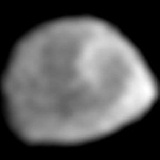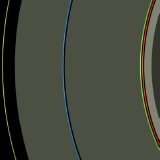 Thebe as observed by the Galileo spacecraft. |
|
| THEBE - MOON OF JUPITER | |
| The nymph Thebe is the daughter of the river god Asopus, and Metope. In some works though she is quoted as one of the Amazons, or as being the daughter of Zeus and the nymph Iodame. Thebe was discovered by Stephen Synnott in 1979 using Voyager 1 images. Like Jupiter's other inner satellites, in Voyager images, it appears as a small dot or a narrow streak. Thebe was first identified by the shadow it cast on Jupiter, which enabled its position to be calculated and for it to be located in other Voyager images. | |
| Orbit | |
| Travelling outwards from Jupiter, Thebe is the fourth moon, and the outermost of the "inner moons". Thebe orbits Jupiter at an average distance of 222,000 kilometres. | |
 The orbits of Jupiter's inner moons. |
|
| Physical properties | |
| Thebe measures about 120 kilometres in diameter, making it the second largest of the inner satellites. It is slightly more spherical than Amalthea or Metis. | |
| Interior | |
| There is no information concerning the interior. | |
| Surface | |
| Thebe is a dark moon, reflecting only 5% of incident sunlight. In this respect it is similar to Jupiter's other inner moons.The best Galileo images show Thebe's leading side (facing the direction of travel). It reveals three relatively large craters. They are about 50 kilometres across, not much smaller than Thebe's radius | |
| Magnetic field | |
| No magnetic field has been detected. | |
| Atmosphere | |
| No atmosphere has been detected, and given Thebe's low gravity and escape velocity, one is not to be expected. | |
| Thebe in Jupiter's rings | |
| Thebe orbits at the edge of the Thebe Gossamer, one of Jupiter's outer rings. Meteoritic bombardment of Thebe's surface and the resultant ejection of dust into orbit around Jupiter is regarded as the most likely origin of Jupiter's ring system. | |
| More about Thebe and Jupiter's rings | |
|
|
|